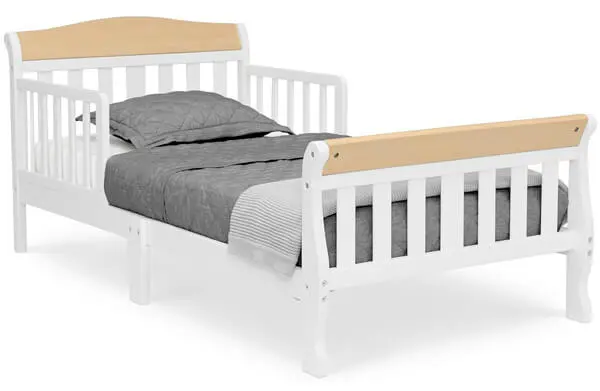One day, your toddler’s crib is their cozy little haven, and the next, they’re ready for the big leagues—the toddler bed. But how can you tell if it’s the right time to make the switch? Here’s how to spot the signs—and some helpful tips to make the transition from crib to toddler bed smoother for both you and your little one.

When is the right time to transition from a crib to a toddler bed?
According to the American Academy of Pediatrics (AAP), a good rule of thumb is to make the transition once your child’s chest is above the crib railing. At that point, they can easily climb out, which increases the risk of injury. This is a crucial factor to consider when deciding if it’s the right time to transition from a crib to a toddler bed.
While there’s no exact age when this switch should happen, it typically occurs between 2 and 3 ½ years old. Many experts recommend waiting until around age 3, but every child is different. If your toddler is regularly climbing out or showing excitement for a “big kid bed,” those are clear signs it might be time to make the change.
Wondering about the pros and cons of making the switch early? Read our article on the advantages and challenges of moving your child to a toddler bed ahead of time.
Signs Your Toddler is Ready to Transition from Crib to Toddler Bed
Here’s what to look out for:
1. They’re Climbing Out of the Crib
When your little one starts climbing out of their crib regularly, it’s more than just a sign of their adventurous spirit—it’s a safety issue. If they escape more than once, it’s likely time to transition to a toddler bed. Pediatric experts recommend making the switch when climbing becomes a consistent behavior to avoid injury.
2. They Show Interest in Big Kid Beds
If your toddler points at older siblings or kids in “big kid beds” with excitement, they may be ready for the change. Showing interest in their own “big bed” is a strong sign they’re up for the challenge, especially if they seem excited about picking out bedding.
3. They’re Outgrowing the Crib
Notice your child doing the starfish and running out of space? If their legs and arms are constantly bumping the crib sides, it might be a clue that they’ve outgrown their crib.
A snug crib could impact sleep quality, so it’s essential to ensure they have enough space to stretch out comfortably.
4. Sleep Habits are Improving
Toddlers who can fall asleep on their own or with minimal help show signs of sleep independence. According to pediatric sleep experts, toddlers demonstrating self-soothing abilities tend to adjust better to sleeping in a toddler bed.
5. Growth Milestones are Being Met
Is your child hitting their developmental milestones? Meeting milestones like walking confidently or communicating needs effectively is a signal they’re ready for new challenges, including a toddler bed.
Creating a Smooth Transition Plan
Switching to a toddler bed can be a big deal, but with the right approach, you can make it stress-free for everyone.
These are a few steps that can make the transition smoother:
- Get your toddler involved
- Establish a solid bedtime routine
- Make the toddler bed inviting
- Be patient with setbacks
- Choose the right time
When we moved our daughter to a toddler bed, we involved her by letting her choose bedding with her favorite colors and fun designs. This small involvement made the transition smoother. So, think about involving your child in these decisions. This involvement helps build excitement for the new sleeping arrangement.
Consistency is crucial during the transition from a crib to a toddler bed. It’s important that you stick to familiar bedtime routines. So, keep things as similar as possible, like a bath, storytime, or a cup of warm milk. This sense of familiarity helps to ease the anxiety that can come with such a big change.
Filling the toddler bed with cozy blankets and your child’s favorite stuffed animals can also help. A comfy and fun bed helps them look forward to sleeping in it.
Don’t stress if the first few nights don’t go perfectly. Regression is normal. Your child may want their crib back or have a few tough nights. If things get tough, avoid going back to the crib, as that can send mixed signals. Stay consistent, calm, and offer comfort—they’ll adjust soon.
Also, avoid making the transition during big life changes like moving or the arrival of a sibling. Picking a quiet time can minimize stress for everyone.
Above all, every child is unique, and patience is crucial!
Ensuring a Safe Sleep Environment
Safety should always come first; therefore, when transitioning your child from a crib to a toddler bed, you must childproof their room to ensure their safety once they leave the confines of their crib.
Here’s how to keep their room secure:
1. Choose the Right Toddler Bed
You’ll want something sturdy with a low height to prevent potential falls. Beds with built-in guardrails or the option to add them are excellent choices. Guardrails are your best friends. They help prevent those unexpected tumbles in the middle of the night. Many toddler beds come with built-in rails, or you can buy separate ones to attach.
2. Remove any Potential Hazards
Lock away hazardous items. This includes cords, small objects, and heavy items that could fall. Keeping the room clutter-free enhances safety. Also, don’t forget about outlet covers and secure heavy furniture to walls.
3. Monitor Sleep Patterns
Keep an eye on your toddler’s sleep patterns and adjust as needed. Initially, you might find they wake up more or move around a lot. That’s normal. Monitor their sleep and make necessary tweaks to keep everyone sleeping soundly.

